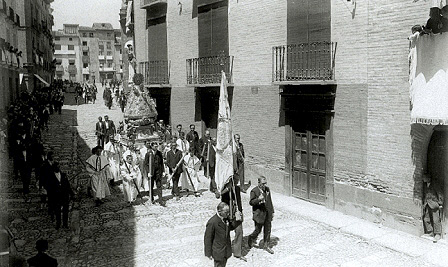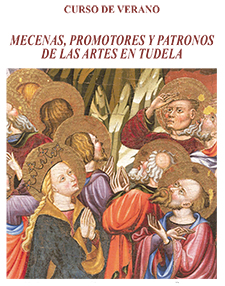PATRONS, PROMOTERS AND PATRONS OF THE ARTS IN TUDELA
August 27, 2014
Around the Patron Saints
D. Ricardo Fernández Gracia. Chair of Heritage and Art of Navarre.
The varied vows that the cities made to commemorate and honor the saints that had protected against all subject of calamities had different developments with the passage of time. Some vows, such as that of San Saturnino in the city of Pamplona in 1611, resulted in the board of trustees of the aforementioned saint over the city, and something similar happened in Tudela with Santa Ana. In 1530 in the capital of the Ribera "took a vow to perpetually keep and celebrate the feast of Lady Saint Anne in every year in perpetuity with a very solemn and devout procession and carrying in the procession the holy image of the Lady Saint Anne with the illuminations that seem to the mayors and aldermen ...". Decades later from the Regiment the board of trustees would be consummated in which it is necessary to indicate some important dates in a sign of identity and devotion that was in crescendo with the passage of time, in which all the own elements of the celebration were integrated: music, bells, giants, gunpowder, bulls and great sermons, these in the incomparable framework of the collegiate, cathedral from ends of century XVIII.

Santa Ana Procession
Los hitos de la devoción a la patrona Santa Ana se pueden señalar en unas fechas concretas. En 1589, el Regimiento encarga el busto de Santa Ana Triplex a Juan de Ayuca, según el modelo de Blas de Arbizu teniendo en cuenta que “a todos es notorio el voto tan solemne que en el año mil quinientos treinta hizo la dicha ciudad….”. En 1590 aprobaron la obra Rolan Mois y Domingo Fernández de Yarza, escultor de Zaragoza. Entre 1590 y 1591 la doró y policromó Juan de Lumbier. En 1656 llegaba desde la seo de Zaragoza la preciada reliquia de la santa que se recibió con arcos triunfales y todo tipo de festejos civiles y propiamente religiosos. En 1680 el cabildo otorgó la concesión del patronato de la capilla a favor de la ciudad y pocos años más tarde, entre 1712 y 1725 se construyó la capilla en un auténtico alarde de hacer la “capilla más ostentosa que puede haber en toda la comarca”, según se recoge en las actas municipales de 1712. La construcción de la capilla de Santa Ana de Tudela, emblemático edificio de la ciudad, se puede dividir en tres etapas. La primera que abarca de 1712 a 1716, en la que se eligieron el sitio y las trazas y se previnieron los materiales de piedra, yeso y ladrillo; la segunda, entre 1716-1720, en que se construyó propiamente la fábrica, y la tercera, entre 1723 y 1725, en que se procedió a decorar con yeserías el conjunto y se colocó el zócalo de piedra y la reja. En todo ese proceso los superintendentes del cabildo colegial y municipal estuvieron al tanto de todos los detalles y contrataciones necesarias para el buen fin de las obras.
En torno a 1735 los tudelanos en un memorial en defensa de su jurisdicción decanal frente al obispo de Tarazona escriben sobre la capilla encendidos párrafos, simulándola como un auténtico caelum in terris: “Obra digna de un monarca y con las fuerzas solas de este pueblo costeada, y sin haber sido necesarias más Indias que los erarios ocultos de devoción finísima explicados aquí por las cuantiosas cotidianas limosnas que piden más de treinta mil pesos consumidos en esta fábrica. No es de nuestra facultad el dibujar los primores milagrosos. En dos palabras puede decirse, sin exageración que su pavimento y zócalo a un estado de alto es todo piedras preciosísimas y lo restante de oro. Sus estatuas compiten con las de Phidias, sus tallas, follajes, trofeos militares, molduras, esculturas y dorados forman toda aquella hermosa varia hermandad que puede desearse para el cielo, pudiendo figurarnos que si la gloriosísima Santa Ana no habitase ya en el empíreo, elegiría para paraíso de sus delicias esta celebérrima capilla, que ha sido admiración de las naciones extrañas que han logrado verla y han puesto en sus elogios las lenguas todas de los curiosos de nuestra España. Aquí en la patrona Santa Ana tenemos para arrastrar al mundo (mejorada la idea de Dinócrates en el gran templo de Arsinoo), más verdadero imán que con más suave fuerza atrae las almas a su adoración obsequiosa”.
La iglesia mayor de Tudela fue la sede de las grandes celebraciones en honor a Santa Ana y a otro patronatos que avaló en municipio con su presencia. Sus pétreos muros se revistieron de retablos e imágenes, de modo muy especial, a partir de la Baja Edad Media y a lo largo de las centurias siguientes, singularmente en pleno Barroco, correspondiendo con una estética caracterizada por la integración de las especialidades artísticas, fundiéndolas en un todo, y por la captación del espectador a través de los sentidos, siempre más vulnerables que el intelecto. Muchas de las imágenes antiguas y modernas tenían que ver con los patronatos de las diferentes capillas que pertenecían a instituciones, gremios, cofradías o nobles patricios.
Las artes integradas se constituyeron en un vehículo de transmisión de doctrina y práctica de poder en un ámbito que trascendía al propio templo, por ser una domus artium además de domus capituli. El regimiento de la ciudad celebró en su interior las grandes ceremonias y fiestas, expresión sublime de cuanto conforma la cultura del Barroco. Música, campanas, fuegos artificiales, protocolo, ceremonial, color, magnificencia y teatralización se dieron cita en numerosos días a lo largo del año y también en ocasiones extraordinarias.
El cabildo con sus hábitos y los regidores con el traje de golilla hasta 1863 en que dejaron de usarlo, con protesta del cabildo, ponían todo su esmero en la solemnización de las fiestas votivas y patronales. Los munícipes engalanaban su traje con las veneras, utilizadas desde 1622, en las que figuran el escudo de la ciudad y la figura de San Pedro ad vincula, por considerar que en su día quedó liberada la ciudad del yugo musulmán. Unas ricas mazas y todo un protocolo municipal contribuían a la imagen del Regimiento.

Veneration of the aldermen of Tudela, used since 1622.
The city had other vows. Among the most celebrated was that of the Immaculate Conception, which was made in 1619 and solemnized annually in the collegiate church, as well as with a tournament in 1620, perhaps the most important of those celebrated in the city in the centuries of the Modern Age. The municipal corporation agreed to make it a holiday in 1646, and to leave the church as a community if the preacher "due to his ignorance or any other cause" failed to proclaim the immaculist mystery. The chapter installed a niche with her image at the door of the church, Canon Murgutio placed an altarpiece in her honor, there were numerous foundations in convents in the city and in 1736 the convent of Capuchinas was founded under the double invocation of the Sacred Heart of Jesus and the Immaculate Conception.

Relation of the festivities held in Tudela in honor of the Immaculate Conception. 1620
In 1627, after solemnly celebrating her beatification a few years earlier, St. Teresa was declared its patron saint. In this case it seems that the agreement had no great significance, leaving the special feast in the Carmen Descalzo, where his feast is described in the mid-eighteenth century as follows: "In his day boasts of having their hearts as capable as his Holy Mother in the prolixity of worship and curiosity of adornment and magnificence of music, sermon, exposed Holy and nap in the afternoon, which is idle warning the contest when Santa Teresa takes the whole world".
Likewise, as head of the javierista faction of the kingdom of Navarre, Tudela made a vow to San Francisco Javier in 1626, swearing to do "the cult and honor that is due to such a great patron saint , following in this the disposition of law and sacred canons ".
A list of the votive feasts with their corresponding procession at the end of the Ancient Regime is the following: San Sebastián (January 20) with sung mass in the chapel of San Jerónimo and attendance of the city; San Gregorio (March 12) also with the presence of the Town Hall; San José (March 19); San Jorge (April 19); San Gregorio Ostiense (May 9) after singing mass in his Shrine of Our Lady of Fair Love and blessing the fields; San Julián (April 22) with sung mass in the Shrine of Our Lady of Fair Love of Santa Quiteria; Santa Ana, patron saint of the city, San Pedro ad vincula (August 1), considered as patron saint of the city, after singing mass in the parish of his titularity; Octave of the Assumption, titular of the collegiate temple; San Marcial (August 31) with mass in his church; Santa Catalina (September 25) with mass in his chapel; Inmaculada Concepción (December 8) in the afternoon and San Nicasio (December 14) with mass in the Merced. Finally, Julio Segura notes that the Virgen de los Remedios, who had a beautiful chapel in San Nicolás, board of trustees of the Aperregui family, was also considered co-patron saint of the city.
PROGRAM
Tuesday, 26th August
Three exceptional altarpieces for three promoters
Ms. Mercedes Jover Hernando. Museum of Navarre
The great patrons of the Renaissance, a mirror of humanism
María Concepción García Gainza. Chair of Navarrese Heritage and Art
Wednesday, 27th August
Around the patron saints
D. Ricardo Fernández Gracia
Chair of Navarrese Heritage and Art
Patrons and patrons of Tudela silverware
D. Ignacio Miguéliz Valcarlos
UNED Pamplona
Patrons and Patronages in the Collegiate ( visit guidada)
Ms. María Josefa Tarifa Castilla. University of Zaragoza
Thursday, 28th August
Town planning and civil architecture
D. Carlos Carrasco Navarro. Doctor in History of Art
The great men of the Enlightenment
D. Pablo Guijarro Salvador. Chair of Navarrese Heritage and Art.
Monarchy, patrons and nuns in the Company of Mary ( visit guided)
D. Ricardo Fernández Gracia
Chair of Navarrese Heritage and Art

